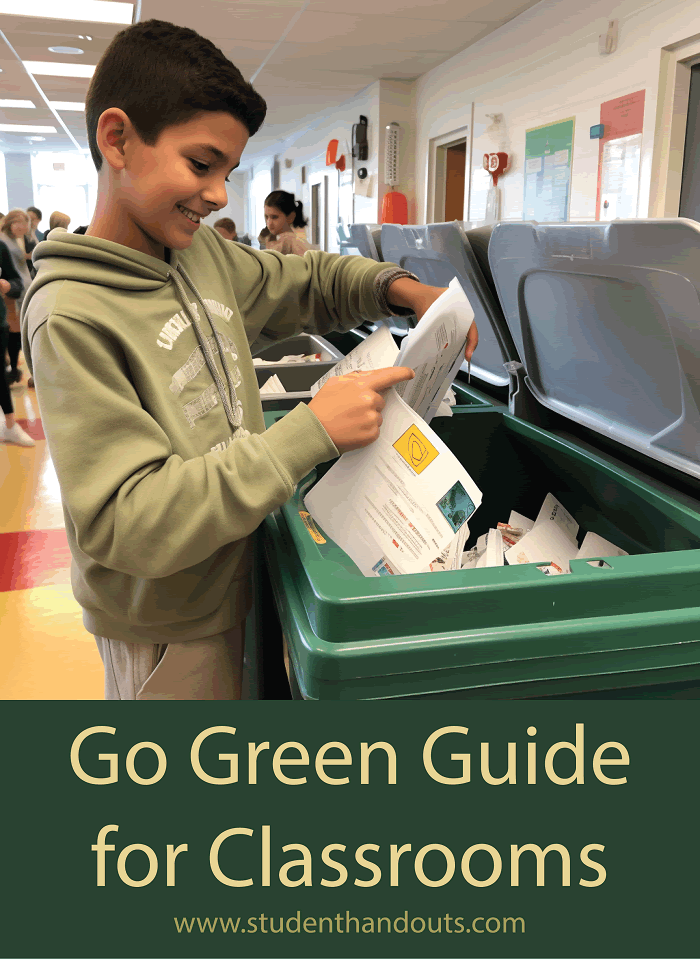 |
Go Green Guide |
| www.studenthandouts.com > Miscellaneous > Go Green Guide |
|---|
Classrooms can take several steps to "go green" and contribute to environmental sustainability. Here are some ways educators, students, and schools can make classrooms more environmentally friendly.
 Reduce, Reuse, Recycle: Set up recycling bins for paper, plastic, and other recyclables in the classroom. Encourage students to use both sides of a sheet of paper and to recycle scrap paper. Consider using recycled or eco-friendly school supplies.
Reduce, Reuse, Recycle: Set up recycling bins for paper, plastic, and other recyclables in the classroom. Encourage students to use both sides of a sheet of paper and to recycle scrap paper. Consider using recycled or eco-friendly school supplies. Energy Conservation: Turn off lights, computers, and other electronic devices when not in use. Use natural daylight whenever possible to reduce the need for artificial lighting. Consider installing energy-efficient lighting and appliances if feasible. Water Conservation: Promote responsible water use by fixing leaky faucets and pipes. Educate students about the importance of conserving water when washing hands or using water for projects. Paperless Teaching and Learning: Embrace digital learning resources and reduce the use of paper. Utilize e-books, online assignments, and digital note-taking tools.  Eco-Friendly Supplies: Choose eco-friendly classroom supplies, such as recycled paper, non-toxic markers, and refillable pens. Avoid single-use plastics and encourage the use of reusable containers and water bottles.
Eco-Friendly Supplies: Choose eco-friendly classroom supplies, such as recycled paper, non-toxic markers, and refillable pens. Avoid single-use plastics and encourage the use of reusable containers and water bottles. Green Decor and Furnishings: Decorate the classroom with plants to improve air quality and aesthetics. Use eco-friendly or upcycled furniture and decor items. Outdoor Learning: Incorporate outdoor learning activities, such as nature walks or gardening, to connect students with the environment. Create a small garden or green space within the school premises. Environmental Education: Integrate environmental topics into the curriculum to raise awareness about sustainability and ecological issues. Invite guest speakers or organize field trips related to environmental science and conservation. Waste Reduction: Minimize waste by using reusable containers and lunchboxes rather than disposable ones. Educate students about the importance of reducing waste and composting organic materials when possible. Community Engagement: Involve students in community clean-up events or environmental projects. Partner with local environmental organizations for educational programs and initiatives. Green Certifications: Explore opportunities to earn green certifications for your school or classroom, such as LEED (Leadership in Energy and Environmental Design) certification or recognition as a Green School. Encourage Active Transportation: Promote walking, biking, or carpooling to school to reduce carbon emissions from transportation. Monitor Energy Usage: Install energy-monitoring devices to track energy consumption in the classroom. Set energy-saving goals and involve students in monitoring progress. Reduce Plastic Waste: Reduce single-use plastic waste by using reusable bags, containers, and utensils in school lunches. Implement policies to minimize the use of disposable plastic items in the classroom. Advocate for Sustainability: Encourage students and their families to make environmentally conscious choices outside of the classroom, such as reducing energy consumption at home and supporting eco-friendly products. Encourage students to become politically active on ecological issues. By incorporating these practices into the classroom environment and curriculum, educators can play a crucial role in fostering environmental awareness and responsible behavior among students. "Going green" not only benefits the environment but also promotes a sense of responsibility and stewardship that can last a lifetime. |
 |
|---|
| www.studenthandouts.com > Miscellaneous > Go Green Guide |
|---|











